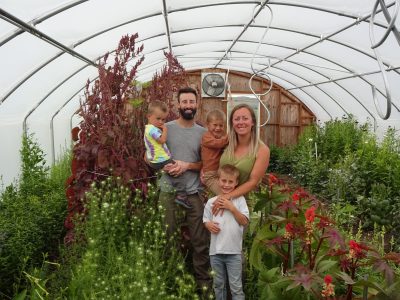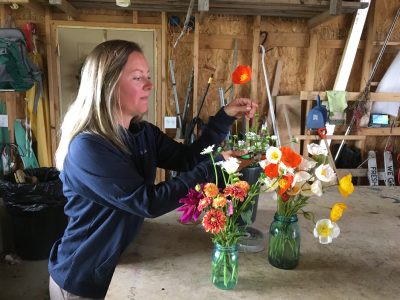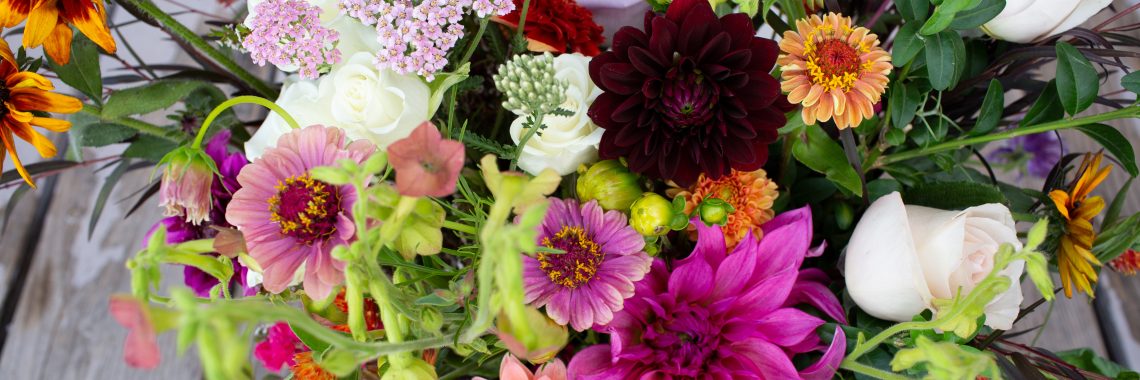BareFoot Brook was born between Saratoga and Riverside, Wyoming. There, artistic talent, green thumbs, and a lot of hard work came together to create a family business that produces locally grown floral creations.
Welcome to Wyoming
Originally from Michigan, Brooke and Jordan Seitz moved to Wyoming to work at the Encampment K–12 School, Brooke as an art teacher and Jordan as a science teacher.

Brooke had always loved growing plants. But she and her husband soon found that growing plants in Wyoming was a little more challenging than in Michigan! (This year, it dropped to 27 degrees in June at their house and the wind hit 90 mph gusts in the spring.)
Unfazed, the couple persisted in growing ornamentals outdoors and putting up a small unheated greenhouse. As their flowers and family grew, childcare and other considerations led Brooke to leave her teaching job. With small children at home, she wasn’t planning to start a business.
Or so she thought. Brooke’s urge to grow plants and use her artistic eye and education to create wonderful flower arrangements soon started her family down the entrepreneurial path.
BareFoot Brook is born
Most flower arrangement designers do not grow their own materials. And yet, four years ago, Brooke found herself designing arrangements to sell locally, using the plants she grew outdoors and in the small greenhouse as well those ordered from other sources.
“Most people don’t do both—they don’t grow and design. But I love both, I can’t really give them up, so I’m just a mad woman,” she says with a laugh.
She says it’s a whole different experience to make arrangements with the flowers she grows versus ones that are ordered. “I grow my own supplies to make my artwork. That’s the best part, it’s so rewarding,” she explains.
High (tunnel) hopes
Driven by her interest in growing as many of the flowers in her arrangements as possible, and by increasing demand, Brooke began dreaming of building a larger protected growing space. She knew that protection from the wind and extreme temperature swings would greatly improve flower production.
Mark Shirley, the local USDA-NRCS (Natural Resources Conservation Service) district conservationist, helped Brooke and Jordan explore funding options for building a large high tunnel. (See USDA-NRCS info at the end of the story.)
After a year of planning, looking for funding, and working through the application process, they received a cost-share covering 60 to 70 percent of the cost of the high tunnel itself from the USDA-NRCS Agricultural Management Assistance (AMA) Program.
The Seitzes say that without this financial assistance, building the 20 ft by 72 ft structure would have been unaffordable.
The NRCS requires the use of an approved manufacturer kit in the projects they fund to deal with the challenging climatic conditions in Wyoming. Extra purlins were added to the structure to help handle the wind and, as an additional weather measure, angled two-by-fours run off the wooden end walls to posts in the ground that act as braces.
The high tunnel is double-layered and squirrel cage fans blow air into the space between the two layers of plastic. This air gap provides insulation that maintains the warmer temperatures inside the structure. It also reduces the amount of slack in the plastic when temperatures are warmer, which keeps it from whipping in the wind and incurring additional wear.
Jordan, who contributes his summers and hours after work to the business, put the high tunnel up mostly by himself. Friends helped skin the structure, but he installed the heating, fans, and irrigation system.
A game changer
The high tunnel has truly been a game changer for Barefoot Brook! Everything the Seitzes used to grow outside now produces at least double that amount inside the high tunnel. Dahlias, which did not bloom until August when grown outside, bloomed so early that harvest began around June 10 this year.
Previously the Seitzes started all the plants in seed trays, then transplanted them, which slowed production. This year they experimented with direct sowing inside the high tunnel in April.
Brooke hand-watered the plants until they germinated, then switched to drip irrigation for the rest of the season. It worked even better than she had hoped.
Learning the ropes
Brooke and Jordan are still learning the nuances of high tunnel growing. Plants grow very well in the protected environment—but so do insects. They quickly discovered that the high tunnel was so well-insulated that temperatures never dropped enough to kill overwintering insects.
The couple uses organic methods for insect control and is experimenting with a variety of strategies. They also make sure there is adequate air movement through the high tunnel to help prevent potential disease issues.
They still use their small greenhouse to grow dahlias and zinnias, which are planted later than in the larger high tunnel. Since the structure is unheated and not insulated, temperatures in the smaller structure drop to the outside temperature at night. This staggered planting provides Jordan and Brooke with flowers when plants in the heated high tunnel are no longer producing.
They also grow some annual and many perennial flowers outdoors. Last year they planted thousands of tulips. Brooke also planted 35 peony plants; three years after planting she will start harvesting.
Flowers and family flourish
BareFoot Brook now produces about as much business as the family can handle without sacrificing all its personal time. Brooke creates flower arrangements for weddings, weekly subscribers, and a local dude ranch. Time and flower supply permitting, she also fills one-time orders.

She works more hours than she did as a teacher, and Jordan’s summer and after-school hours are filled. The time and work they invest in their business is truly impressive, as is their commitment to creating a beautiful homegrown product.
Brooke’s ultimate goal for the business is to grow all the flowers used in her arrangements. She is well on her way!
A week in the life of Barefoot Brook
Brooke grows many annuals and tender perennials in the high tunnel, including strawflowers, paper daisies, cosmos, dahlias, rudbeckia (black-eyed Susans), scabiosa, pansies, clarkia, orach, snapdragons, gomphrena, nigella, bachelor buttons, sunflowers, bupleurum, flowering tobacco, bells of Ireland, borage, basil, Queen Anne’s lace, zinnias, explosion grasses, and Iceland poppies.
In the summer, it takes up to two hours each day to harvest the flowers. Each species is harvested at a particular stage of development and treated in a specific way so that it lasts as long as possible. This might include cleaning flowers in a particular way, holding them at a specific temperature, and much more!
After harvesting, Brooke starts designing orders and then the maintenance tasks begin—weeding, checking the irrigation, fixing netting, and more. On Wednesdays, she fulfills all of the week’s orders, which are delivered on Thursdays. She and Jordan collect the vases from the past week’s arrangements, clean them, and then the weekly cycle begins again.
The USDA-NRCS Agricultural Management Assistance program
Through the Agricultural Management Assistance (AMA) program, the U.S. Department of Agriculture’s Natural Resources Conservation Service (USDA-NRCS) offers financial assistance to eligible producers interested in diversification, natural resource conservation practices, or marketing.
USDA-NRCS also helps producers build high tunnels to increase local availability of fresh vegetables for sale in Wyoming communities. Visit https://www.nrcs.usda.gov/contact/state-office-contacts/wyoming-state-office to contact your local NRCS district conservationist and explore options in your area.
Jennifer Thompson is the small acreage outreach coordinator for the University of Wyoming Extension. She is always interested in learning more from those who grow great things around our state!
[Story reprinted from the Fall 2022 issue of Barnyards & Backyards magazine.]






